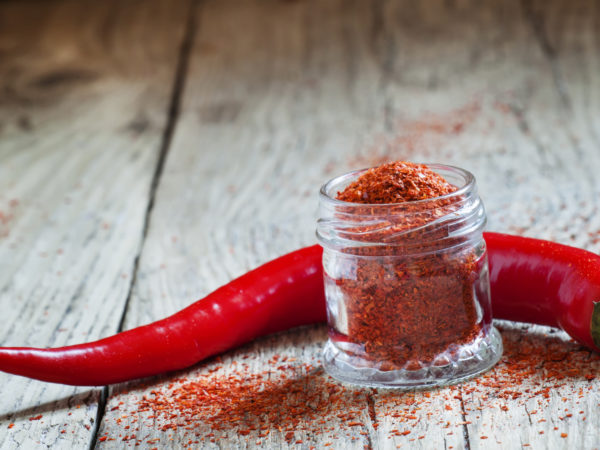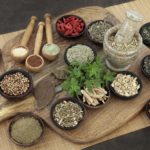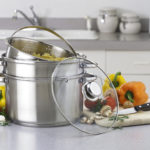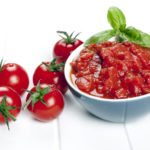Cooking With Spices: Cayenne Pepper

Hot and spicy, cayenne pepper (Capsicum annuum) is a member of the Capsicum family of vegetables, commonly known as chili peppers. The name “cayenne” comes from the town where these peppers originated, in French Guiana off the northeast coast of South America.
Chili peppers, including cayenne, originated thousands of years ago in Central and South America – not surprising considering those regions are known for their spicy flavors. First used as decoration, their usefulness expanded into medicinal and culinary areas. Christopher Columbus became familiar with chili peppers when he explored the Caribbean Islands and brought them back to Europe as a substitute for the cost-prohibitive black pepper. Today, cayenne and other chili peppers are grown on all continents.
Cayenne peppers have a high concentration of capsaicin – the substance that causes their fiery hot sensation. Capsaicin also inhibits substance P, a neuropeptide associated with inflammatory pain processes. Capsaicin has been studied intensively for a variety of health benefits. The health benefits of cayenne include using it as a topical analgesic – several clinical studies show that capsaicin cream can temporarily relieve chronic pain due to rheumatoid arthritis, osteoarthritis, psoriasis, shingles and diabetic neuropathy.
Further study is needed to confirm results that indicate topical cayenne can be used for back pain and cluster headaches. Orally, cayenne pepper can promote cardiovascular health, suppress appetite and increase the burning of body fat (a process called thermogenesis). It has also been shown to help prevent ulcers and drain congested nasal passages.
Modern herbalists recommend cayenne to stimulate the circulatory system, and as a treatment for upper respiratory infections. One common preparation uses cayenne with lemon juice and honey as a syrup for sore throats.
Cayenne pepper is also known for its immune boosting potential: besides the anti-inflammatory effects of capsaicin, cayenne is also an excellent source of carotenoids, including beta carotene – a powerful antioxidant that can help prevent free radical damage. Its high levels of vitamin A (two teaspoons of cayenne pepper provide 47 percent of the daily value for vitamin A) support immune function as well.
In addition to being an excellent source of vitamin A, cayenne pepper is a good source of vitamin E, vitamin C, B6, vitamin K, manganese and dietary fiber.
Cayenne pepper can be used fresh or dried. Fresh green or red cayenne peppers can be used in a fashion similar to fresh jalapeños: as a garnish or chopped up and added to dips, sauces, soups and main courses. You can lower the spiciness level by removing the seeds. Do this while wearing gloves and avoiding contact with the eyes and face to minimize transferring the painful irritants to sensitive areas. You can also dry fresh, ripe red cayenne peppers. Simply wash and place on a wire rack until dry and brittle, which takes about three weeks. These whole, dried peppers can be stored in a sealed container away from light for up to a year.
Dried cayenne pepper is more versatile and works as well as fresh in most dishes. For true cayenne lovers, the challenge is not finding foods that the dried pepper enhances; rather, it’s finding any that it cannot improve. It can be added to cocoa for a bit of spice, and when paired with lemon juice works with virtually all vegetables. Dried cayenne should be kept in a tightly sealed glass jar, away from direct sunlight. It will last for up to three years.
Dr. Weil’s take:
Cayenne pepper is rated at 30,000-50,000 Scoville heat units (a measurement scale which rates the “hotness” of a spice or sauce derived from a chili pepper). That compares with the milder jalapeño’s 2,500-5,000 units. A little goes a long way!
Here in the American Southwest, chili peppers and cayenne are staples. At True Food Kitchen we incorporate chili pepper into both savory and sweet dishes. It’s a delicious addition to hot chocolate.
Finally, there are a few unusual applications: if you tend to get cold feet in the winter, a small amount of cayenne powder sprinkled into your socks may help (just make sure there are no open cuts or blisters on your feet). If you are prone to ulcers, you can try red pepper tea: steep one-quarter teaspoon of cayenne pepper in a cup of hot water.
Recipes with cayenne:










